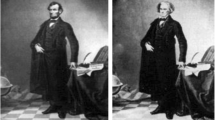Abstract
In this study, an improved image blind identification algorithm based on inconsistency in light source direction was proposed. And a new method defined as “neighborhood method” was presented, which was used to calculate surface normal matrix of image in the blind identification algorithm. For an image, there is an error function between its actual light intensity and calculated light intensity, and for different light source models, there are different constraint functions of light. Light source direction which makes both error function and constraint function get the minimum is the one we want to seek. On this basis, according to the error function and the corresponding constraint function, search means and the Hestenes–Powell multiplier method were used in the improved algorithm to calculate the light source direction for local and infinite light source images, respectively. Further, the authenticity of image can be determined by the inconsistency in light source direction of different areas in the image. Experimental results showed that the light source direction of different areas in an image could be calculated accurately, and then the image tampering can be detected effectively by the improved algorithm. Moreover, the performance of the improved algorithm of the proposed blind identification is superior to that of the existing one in terms of detection rate and time complexity.
Similar content being viewed by others
References
Yao ZL, Wu Q, Li GH, Tu D (2004) A recoverable and active digital signature approach for image: RADS. In: Proc international conference on computer communication (ICCC), Beijing, China. Springer, Berlin, pp 541–546
Lin CY, Chang SF (1998) Generating robust digital signature for image/video authentication. In: Proc ACM multimedia’98, multimedia and security workshop, Bristol, UK, pp 49–53
Lin CY, Chang SF (1998) A robust image authentication method surviving JPEG lossy compression. In: Proc IS and T/SPIE symposium on electronic imaging science and technology (EI’98)-SPIE storage and retrieval of image/video database, San Jose, USA
Yao ZL, Li GH, Tu D, Gan YL (2003) A recoverable active digital signature method for digital image: RADS. J Comput Eng Sci 25(1):29–32
Liu KC, Chou CH (2009) Robust and transparent watermarking scheme for colour images. J IET Image Process 3(4):228–242
Saraju PM, Bharat KB (2008) Invisible watermarking based on creation and robust insertion-extraction of image adaptive watermarks. ACM Trans Multimedia Comput Commun Appl 5(2):1–22
Winne DA, Knowles HD, Bull DR, Canagarajah CN (2002) Digital watermarking in wavelet domain with predistortion for authenticity verification and localization. Proc SPIE 4675:349–356
Paquet AH, Ward RK, Pitas I (2003) Wavelet packets-based digital watermarking for image verification and authentication. J Signal Process 83(10):2117–2132
Zhou X, Duan XH, Wang DX (2004) A semi-fragile watermark scheme for image authentication. In: Proc 10th IEEE int multimedia modelling conf
Paquet AH, Ward RK (2002) Wavelet-based digital watermarking for image authentication. In: Proc IEEE Canadian conference on electrical and computer engineering (CCECE), Winnipeg, Manitoba, Canada, pp 879–884
Wu Q, Li GH, Tu D, Sun SJ (2008) A survey of blind digital image forensics technology for authenticity detection. Acta Automat Sinica 12:1458–1466
Zhang P (2008) The research for digital image splicing detection. Master thesis, DUT University
Zhou LN (2007) Study of digital forensics based on image content. Ph.D. thesis, BUPT University
Johnson MK, Farid H (2005) Exposing digital forgeries by detecting inconsistencies in lighting. In: Proc ACM multimedia and security workshop, New York, USA, pp 1–10
Du XW, Yang YJ, Li MM (2006) Further studies on the Hestenes–Powell augmented Lagrangian function for equality constraints in nonlinear programming problems. Oper Res Trans 10(1):38–46
Elias J, Tobias D (2007) Technical communique: the Lambert W function and the spectrum of some multidimensional time-delay systems. Automatica 43(12):2124–2128
Zhang Y, Xiong F, Zhang GL (2008) A preprocessing algorithm for illumination invariant face recognition. J Image Graph 3(9):1707–1712
Sun XB, Yin J, Li DH, Xiao BL (2008) Point in polygon testing based on normal direction. J Opt Precis Eng 16(6):1122–1126
Nillius P, Eklundh JO (2001) Automatic estimation of the projected light source direction. In: Proc the IEEE computer society conference on computer vision and pattern recognition
Geusebroek M, Burghouts GJ, Smeulders AWM (2005) The Amsterdam library of object images. Int J Comput Vis 61(1):103–112
http://www.cs.washington.edu/research/imagedatabase/. Object and concept recognition for content-based image retrieval. Department of Computer Science and Engineering, University of Washington
Author information
Authors and Affiliations
Corresponding author
Rights and permissions
About this article
Cite this article
Lv, Y., Shen, X. & Chen, H. An improved image blind identification based on inconsistency in light source direction. J Supercomput 58, 50–67 (2011). https://doi.org/10.1007/s11227-010-0531-y
Published:
Issue Date:
DOI: https://doi.org/10.1007/s11227-010-0531-y




